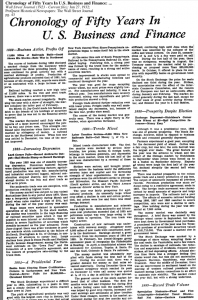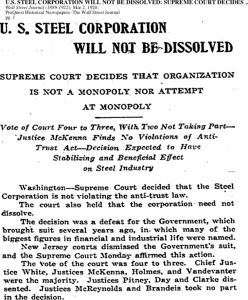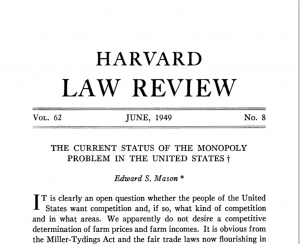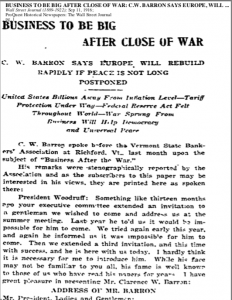
In 1932, a chronology of 50 years in US business was written in the Wall Street Journal. It was published in New York, NY by Dow Jones & Company. Its’ purpose was to inform people of the United States on how businesses have changed over the last half a century and the audience was people in the United States who were unaware of these changes and developments. The chronology covers the years between 1882 and 1932. Each year in this 50 year period is highlighted and a paragraph is written about them detailing what exactly happened in that year to make business change. This source’s relation to this exhibition is that it encompasses the exact changes that were made within businesses. The beginning shows that most business was centralized around railroads, but by 1932 the types of big businesses had increased severely. This source does a very good job at detailing the growth of businesses during the specific time period that this exhibition will highlight. This was found through a proquest search.

In 1920, Dow Jones & Company Inc published an article in New York, NY in the Wall Street Journal about the US Steel Corporation and how it will not be dissolved despite being a monopoly. The intended audience would be people who were concerned with the growth of monopolies and people with interest in the rise of big business. The key issue of this source is that US Steel showed many monopolistic tendencies yet was still ruled to not be a monopoly. It was ruled in this court decision that there were no violations of law in place by Standard Oil. This decision was expected to have a stabilizing and beneficial effect on the steel industry, but it was also seen as a loss for the government who were attempting to stop monopolies. This relates to this topic because the focus of this article is on the failure to disband a monopoly. This WSJ article was also found on Proquest.

On June 1, 1949, the Harvard Law Review published a book with a chapter called The Current Status of the Monopoly Problem. This was published with the intent of analyzing how markets should react to monopolies and if they should even be allowed. It broadly covers all aspects of monopolies. A second section covers the legality in terms of monopolies while given multiple examples of recent court cases during the time of this book’s publishing. It concludes with detailing of the objectives of the antitrust policy. This section speaks of what antitrust policies should do in an attempt to stop monopolies from becoming dangerous and toxic. Monopolies contributed largely to the creation of big businesses and are also almost singlehandedly responsible for all of the negative impacts of the rise of big business. This source was found through the Business Source Complete database from the Waidner-Spahr Library.

In 1916, Dow Jones & Company Inc produced an article in the Wall Street Journal entitled Business to be Big After Close of War. This article was published in New York, N.Y. The intended audience of this article is people who fear for the future of business following World War I. The article depicts and directly quotes C.W. Barron and his speech before the Vermont State Bankers’ Association at Richford in which he spoke about business after the war. Barron speaks of the business war, international business, the end of the war, American problems and foreign trade. One of the major points that he made was that the war was actually beneficial for the United States in terms of business, for they grew tremendously. The article also makes the claim, that at this time, it is no longer possible for business and politics to be separate, the must be interconnected. This can be related to the theme of this project, for it relates to a change in big business and its’ development after the first world war, which was a major turning point. This source was found through a Proquest search.
